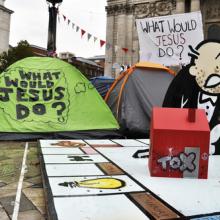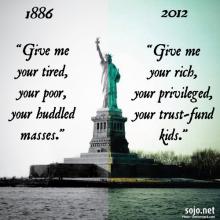99%
IN THE 2015 speech announcing his candidacy for president, Donald Trump declared, “The American dream is dead.” The people of Lancaster, Ohio, a small town at the edge of Appalachia, heard him loud and clear and later gave him 60 percent of their votes. Glass House: The 1% Economy and the Shattering of the All-American Town , by Lancaster native Brian Alexander, shows in fine-grained detail how the American dream of opportunity and fairness died in Lancaster and in similar towns all across the middle of the country.
Lancaster should have been the last place you would look for evidence of American decline. In 1947, a Forbes magazine cover story depicted it as “the All-American town.” It had a thriving manufacturing economy, a burgeoning middle-class, and enlightened civic leadership. For reasons of history and geography, Lancaster also had a reputation as “the whitest town in America,” but that didn’t bother Forbes too much back then.
The Lancaster of Alexander’s childhood and youth sounds a lot like Bedford Falls in the movie It’s a Wonderful Life, but as the 20th century wore on, the town turned into Pottersville. When Alexander went back to write this book, he found that the glass factory where his father had worked was demolished. Most people had to drive an hour or more to Columbus for a job, civic life was deteriorating, and opioid addiction was rampant.
The main foundation of Lancaster’s All-American past was Anchor Hocking, a Fortune 500 glass manufacturer. According to Alexander, the industrialists who built Anchor Hocking in the early 20th century were real George Bailey types. Sure, they wanted to make a buck, but they were suckers for fuzzy-headed notions about the common good that led them to subsidize various public amenities for the town and cooperate with the unions that delivered a family wage to generations of Lancastrians. In those days, we learn, executives and managers might live on the same block with machine operators and share beers at the same local tavern.
While having lunch recently with Harvard Professor Robert D. Putnam, I was asked an interesting question.
Putnam is appalled at the radical lack of equality of opportunity in the U.S. today, and he wanted to know if evangelical preachers would dare to say what his pastor said when he was a teenager. Putnam told me that back then, in the midst of Martin Luther King’s great campaign against segregation, his devout Methodist pastor dared to preach that “racism is a sin.”
Professor Putnam asked me, as an evangelical, whether evangelical pastors today would be ready to declare today’s great economic inequality of opportunity a sin. That’s a great question.
“Middle class” is the chemical weapon of political warfare. We know applying the “middle class” label broadly works and can help us win in the short term. But those victories come at a cost to who we are … and tend to result in long-term (and not insignificant) casualties for those we are supposedly fighting to defend.
Republicans are the Party of the Rich. Democrats now fashion themselves the Party of the “Middle Class.” Can anyone think of a group left with no champion? Here’s a hint: 20 percent of Americans with a full-time job are getting paid so little that--even with both parents working full time—their family of four is still living in poverty. But when’s the last time you heard a Democratic politician even mention the word “poor?"


